Hydronics Workshop | John Siegenthaler
The convergence of hydronics
Modern hydronic technology binds new technologies and desired outcomes together and creates unprecedented market opportunities.
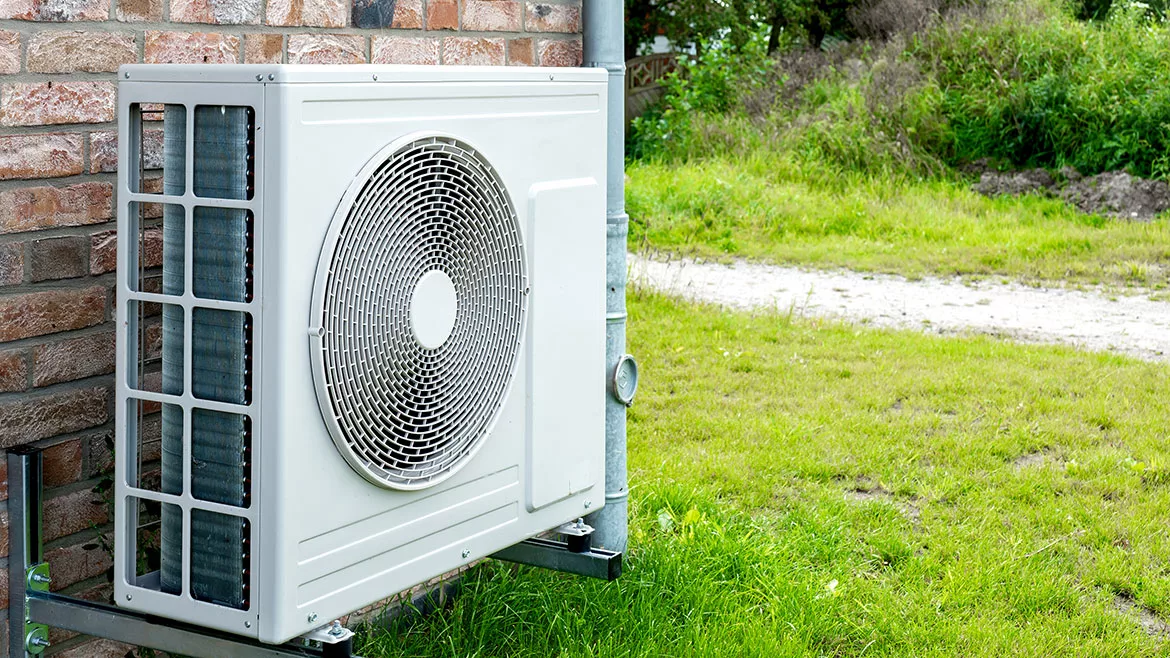
Image Source: Fotomax / iStock / Getty Images Plus
2024 was a banner roll-out year for several companies entering the North American air-to-water heat pump market. There were at least nine new offerings at the AHR show in January compared to the previous year, and from companies that had not previously shown products in this category.
By the end of 2024, at least 18 companies have (or plan to have) air-to-water heat pumps available on the U.S. market. Here’s a listing of those companies as of mid-2024:
- Aermec;
- Arctic Heat Pump;
- Chiltrix;
- Daikin;
- Electro Industries;
- Enertech Global;
- GREE;
- Hitachi;
- IBC (Rheem);
- LG;
- Multiaqua;
- Nordic;
- NTI (Ariston);
- SpacePak;
- Stiebel Eltron;
- U.S. Boiler;
- Viessmann; and
- Weil McLain.
Product availability is certainly crucial to cultivate the market. So is a willingness on the part of hydronics professionals to use new methods and materials. The latter also looks promising.
Based on a poll conducted during a March 2024 webinar, 30% of several hundred respondents, which included engineers, contractors, and wholesalers, indicated they would be recommending an air-to-water heat pump system to their customers. Another 24% of respondents indicated they are likely to be asked for such systems by potential customers.
Momentum is also building due to government manipulation of energy markets. In February 2024, nine states entered into a memorandum of understanding that targets heat pumps to provide 65% of residential heating and cooling sales by 2030.
You may or may not agree with these government heat pump targets, but you can’t deny that they will change the residential HVAC market in the years ahead, and in doing so create profitable opportunities for those who choose to participate.
Intersecting interests
Imagine a way to merge all of the following technologies and desired outcomes:
Technologies:
- Air-to-water heat pumps;
- Time-of-use electrical rates; and
- Thermal storage.
Desired outcomes:
- Superior comfort; and
- High energy efficiency.
All three of these technologies have existed for years, but, to date, have not dominated the HVAC market. That’s likely to change as energy markets shift toward electrification and utilities create new time-of-use rates structures to meet increasing demand without undesirable peak loads.
Modern hydronic technology, when properly executed, can serve as the “glue” to bind these technologies and desired outcomes together, and create unprecedented market opportunities in the process.
A basic platform
As is true with most things hydronic, there are multiple ways to combine components into systems that achieve specific goals.
Some approaches are overly simple and overlook opportunities to improve comfort, efficiency or reliability.
Other approaches are “hardware intensive.” They contain lots of components intended to address every potential operating contingency, but at significantly higher cost and complexity that, in many cases, isn’t economically justified.
So what’s a reasonable approach for a system that can leverage all the previously mentioned technologies while providing excellent thermal and distribution efficiency? Take a look at Figure 1.
FIGURE 1

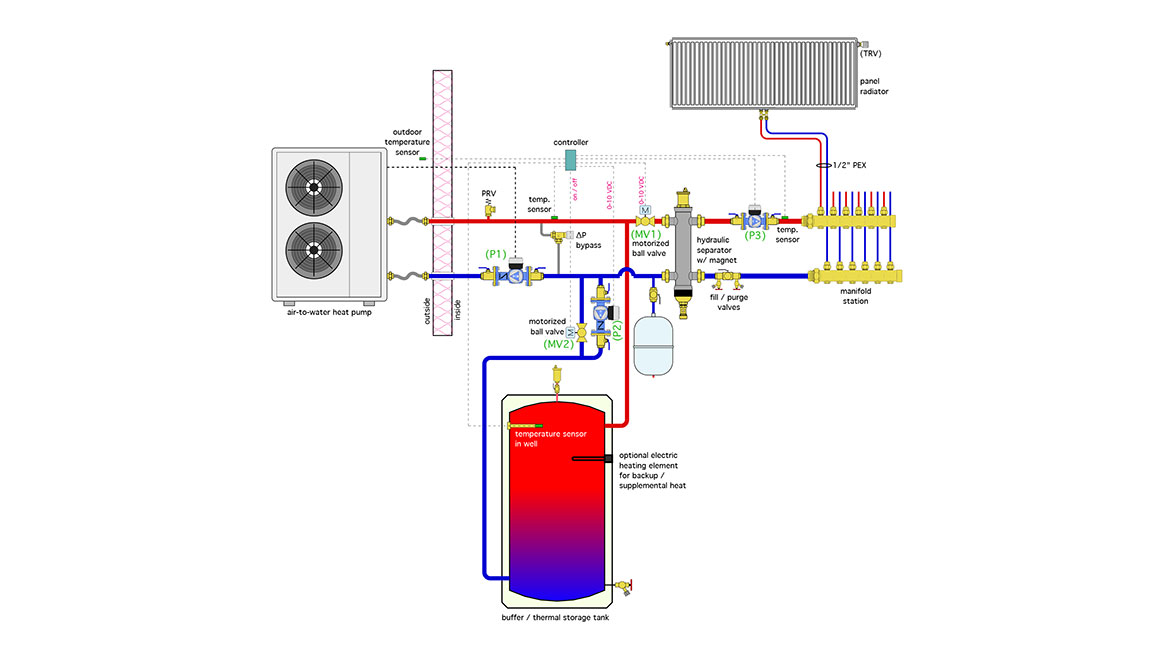
This system uses a monobloc air-to-water heat pump as its primary heat source, along with individually-controlled panel radiators for heat delivery. The insulated tank provides both buffering and thermal storage. The latter mode allows the system to coordinate operation with time-of-use electrical rates. The heat pump can “charge” the tank with heat when electrical rates are low.
The tank is shown with an optional electric heating element, which could be used for supplemental or backup heat.
Additional components include two motorized ball valves (MV1, MV2), two variable-speed circulators (P2, P3), a hydraulic separator with magnet, a manifold station, pressure relief valve, differential pressure bypass valve and fill/purging valves. Motorized valve (MV1) is a modulating valve controlled by a 0-10 VDC signal. Motorized valve (MV2) is a 2-position valve (e.g., either fully open or fully closed).
The hydraulic separator serves a simple homerun distribution system. Each panel radiator is supplied by 1/2-inch PEX tubing, and equipped with a thermostatic valve that modulates flow as needed to keep the room at a desired comfort setting. Circulator (P3) operates 24/7 during the heating season. Its speed is regulated based on constant differential pressure control. As the thermostatic radiator valves open, the circulator automatically increases speed and vice versa. In most locations, a small circulator that only requires about 45 watts power input at full speed is adequate for this type of system in a residential application. Its typical operating cost at a location where electricity costs $0.20 per kWh, and it’s average power input is 30 watts, would be about $0.15 per day. If all the radiator valves are fully closed, the circulator goes into a “sleep” mode at about 9 watts electrical input. It “wakes up” when one or more of the thermostatic valves start to open.
Don’t stir it
In systems with water-based thermal storage, it’s important to maintain temperature stratification within the tank (e.g., hottest water at top, coolest water at bottom). Without going too deep into thermodynamic theory, a stratified tank provides better “usability” of the heat it contains compared to a fully mixed tank containing the same amount of heat.
When an air-to-water heat pump is used to add heat to the tank, there’s an operating characteristic that, if uncorrected, can quickly destroy this stratification. It happens when the heat pump turns on its circulator for two or three minutes before starting its compressor. This control action is typical of most air-to-water heat pumps. It’s how the heat pump’s internal controller verifies adequate water flow prior to operating the compressor. In this system, this control action would result in water from the bottom of the storage tank passing through the heat pump without any heat being added. That water would then be injected back into the top of the thermal storage tank. This all but destroys and existing temperature stratification, and in doing so, reduces the thermodynamic usefulness of the stored energy.
This can be prevented through the combined use of the motorized valves (MV1) and (MV2), and the ∆P bypass valve. When the heat pump first starts, and its circulator is operating, valves MV1 and MV2 remain closed. This forces flow leaving the heat pump through the differential pressure bypass valve, which has been set to a pressure high enough to remain closed when either (MV1) or (MV2) are open. The minimum thermal mass of the circuit between the heat pump and bypass valve allows the temperature leaving the heat pump to rise quickly. A differential temperature controller monitors this temperature as well as the temperature at the top of the thermal storage tank. When the heat pump’s leaving temperature rises slightly above the temperature at the top of the tank, the differential temperature controller opens valve (MV2) to allow flow from the lower portion of the tank to return to the heat pump. This helps preserve beneficial stratification within the tank.
One mode at a time
To understand how this system works, it’s helpful to examine each mode individually. We’ll start with a mode where the heat pump is “charging” the tank with heat, which is shown in Figure 2.
FIGURE 2

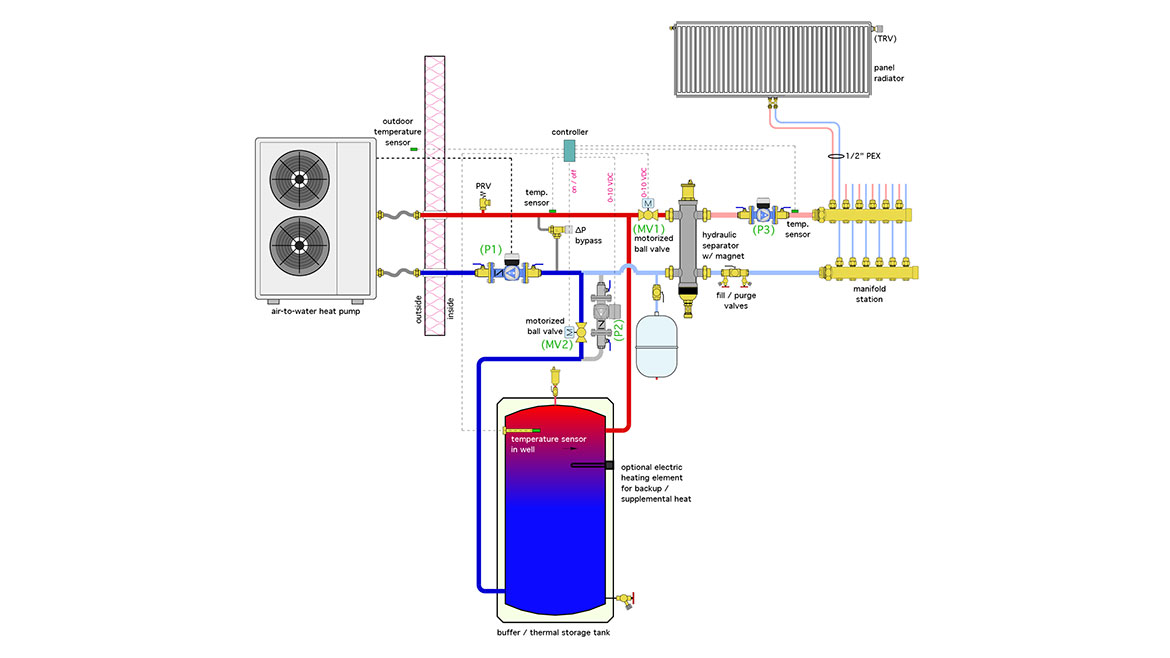
Circulator (P1) creates flow through the heat pump. As soon as the water temperature leaving the heat pump rises a few °F above the temperature at the top of the tank, motorized valve (MV2) opens, allowing flow to return from the lower portion of the storage tank to the heat pump. Motorized valve (MV1) modulates as necessary to create a suitable supply water temperature for the distribution system. That supply temperature is based on outdoor reset control. The amount of flow passing through (MV1) determines the mixed supply water temperature to the panel radiators. That temperature is sensed downstream of distribution circulator (P3). If there is minimal flow demand to the panel radiators, most of the flow from the heat pump passes to the thermal storage tank. This control logic ensures that comfort is maintained while sending any access heat production to thermal storage when electrical rates are low.
The time during which the system could operate in this mode depends on the rate of heat output from the heat pump, the volume of the tank, the allowed temperature increase in the tank and what electric utility rate is available.
For example, a heat pump delivering an average of 30,000 Btu/h to storage could raise the temperature of 119 gallons of a 30% solution of propylene glycol and water about 33° F in one hour. Heating the tank from say 100° to 130° F is a reasonable requirement for modern air-to-water heat pumps, especially those operating on R-32 or R-454B refrigerant. Even higher temperatures are possible when air-to-water heat pumps operating on CO2 or R-290 (propane) refrigerant become more available in North America.
Globally, there are air-to-water heat pumps using cascading refrigerant systems, or operating on R-290 (propane) refrigerant that can supply water temperatures of at least 170° F, but these have minimal availability — or no availability — in the U.S. at this time. Still, it’s likely that these higher-temperature heat pumps will eventually make their way through the maze of approvals needed to enter the U.S. market. They will be particularly useful when combined with water-based thermal storage systems.
During thermal storage charging mode the heat pump remains on, at full capacity, until the tank temperature rises to some high limit based on what the heat pump is capable of.
Storage to load
Figure 3 shows the system supplying heat from the thermal storage tank to the emitters, while the heat pump is assumed to be off.
FIGURE 3

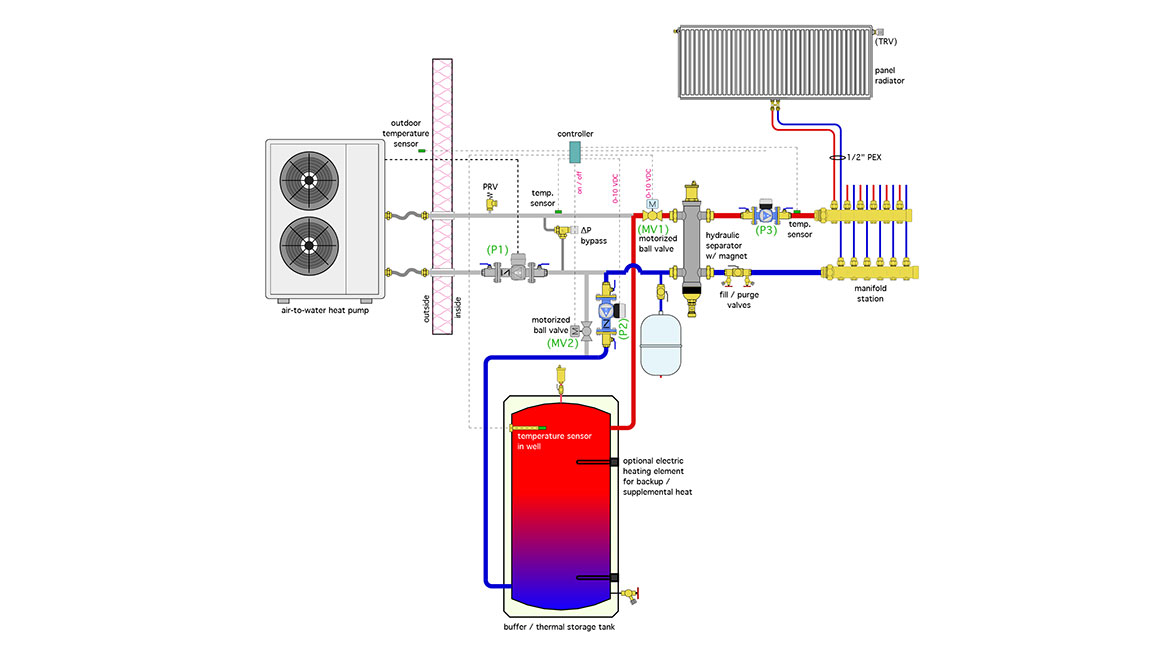
The flow rate of heated water from the tank is controlled by variable-speed circulator (P2) using a 0-10 VDC control signal. Motorized valve (MV2) is fully closed. Motorized valve (MV1) is fully open. The flow created by circulator (P2) mixes with flow returning from the heat emitters to create the desired supply water temperature upstream of the manifold station. This is a form of injection mixing. As the temperature of the storage tank cools, the flow rate created by circulator (P2) increases to maintain the desired supply water temperature as long as possible.
When the tank can no longer maintain this temperature the system switches to a mode that depends on the type of heat pump used.
When a variable speed “inverter” heat pump is used, the supply water temperature to the heat emitters is controlled by varying the heat pump’s compressor speed. This mode is shown in Figure 4.
FIGURE 4

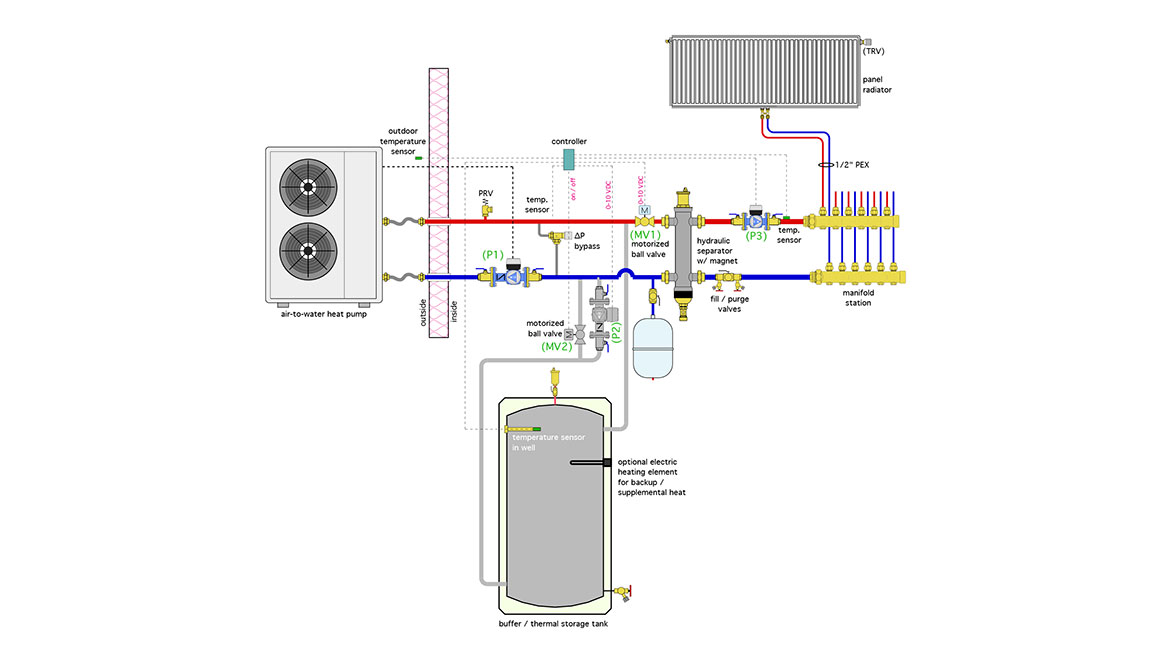
If a fixed-speed heat pump is used, the thermal storage tank can operate as a buffer tank. The heat pump runs until the temperature at the top of the tank is a few degrees above the target supply temperature to the heat emitters, at which point, it turns off and remains off until its temperature drops a few degrees below the current target supply water temperature. During this “cool down” period, circulator (P2) operates at a speed that can maintain the target supply water temperature to the load.
The hydraulic separator allows the flow rate through the heat pump to be different from that through the heat emitters. It also provides air, dirt and magnetic particle separation for the system.
Adding on
It’s also possible to expand the capabilities of this basic platform to include domestic water heating and central cooling. Figure 5 shows both subsystems.
FIGURE 5

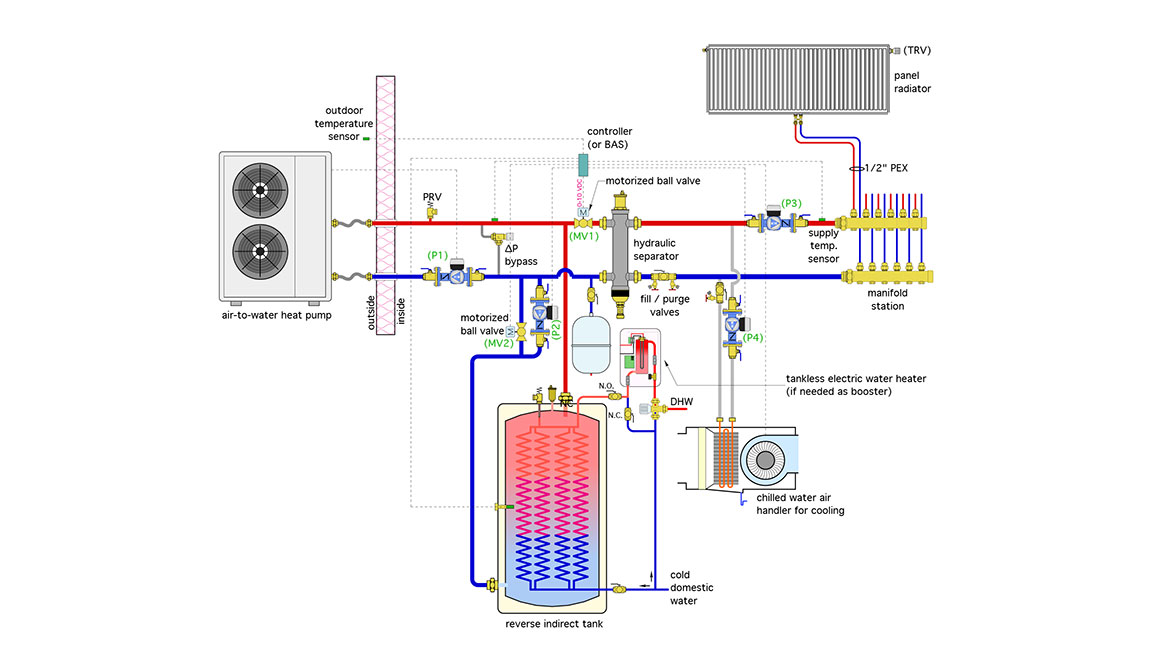
Domestic water is heated as it passes through the coils inside the reverse indirect water heater, which also serves as the system’s thermal storage tank. If the tank temperature is maintained sufficiently high by the heat pump (such as between 115° and 125° F), the domestic water can be fully heated to a usable temperature as it passes through the tank’s internal coils. If the tank temperature is maintained based on outdoor reset control, some type of electric booster (tank-type or tankless) can be used to bring the domestic water to the required supply temperature. Some heat pumps can be configured to operate in outdoor reset mode when directly supplying the heat emitters and switch to a setpoint mode upon a call for domestic water heating. The latter is typically treated as the priority load. Be sure to include a thermostatic mixing valve on the outlet side of the domestic water heating subassembly.
Cooling is provided by a ducted air handler with a chilled water coil. Flow through the air handler is created by circulator (P4). By using a dedicated circulator for cooling, there is no concern about sizing or speed control for the heating distribution circulator (P3) if it were to be used for cooling mode.
With a system that provides space heating, cooling and domestic hot water, it’s necessary to provide priority controls to handle a situation where cooling and domestic water heating are called to operate at the same time. I favor making domestic water heating the priority load. The tank temperature can usually be recovered in a few minutes of warm weather operation. During this time, the air handler’s blower can remain on but there would be no cool fluid passing through the air handler’s coil.
Maintaining control
The piping layouts shown in Figures 1 through 5 are relatively simple. The hardware used is all available from multiple sources. However, coordinating the control functions using currently available single-function controllers, while possible, is cumbersome. I’ve done the design for this. The system — without the cooling option — requires five single-function controllers, five relays, and a fair amount of wiring to tie everything together.
An alternative “brain” for this system would be a programmable and relatively inexpensive micro-controller such as an Arduino that provides the digital and analog outputs needed to turn devices on or off, as well as control the speed of circulator (P2) and the modulation of valve (MV1). Perhaps some enterprising individuals will seize this opportunity. The hardware is inexpensive and readily available, it’s mostly a matter of writing software to drive the micro-controller.
The future of home heating and cooling will involve heat pumps and time-of-use electric utility rates that leverage demand side management of energy. Thermal storage will be increasingly part of that convergence. Hydronics technology provides a platform to bring all these concepts together and at the same time provide unsurpassed comfort.
It’s available in the present, and ideally positioned for the future.
Looking for a reprint of this article?
From high-res PDFs to custom plaques, order your copy today!






